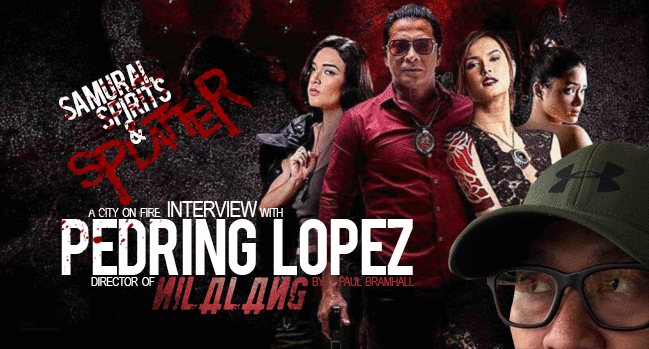
It was a particularly humid day in October when I found myself strolling through the streets of Makati in Manila, the capital of the Philippines, to meet with up and coming director Pedring Lopez at his post-production house located in Legaspi Village.
It was a public holiday, so the normally bustling streets, filled with honking jeepneys and exhaust fumes, were eerily quiet for a Monday. It struck me that it was the perfect setting for a tropical climate zombie movie, and the thought crossed my mind that what better person to direct such a concept than Lopez himself. Having cut his teeth on the haunted house tale Binhi, Lopez soon found himself on the international radar thanks to his follow-up, the action/horror hybrid Nilalang.
The combination of having a shape shifting demon, a Japanese adult movie actress as one of the main stars, and production values on a level that are rarely seen in Filipino genre movies, proved to be a winning one, with screenings at multiple film festivals all over the world. I was curious as to how Nilalang had come into being, and what Lopez himself thought of the future for genre filmmaking in the Philippines.
The director already has his next movie lined up, which promises to be an action extravaganza with Mark Dacascos in the lead role, entitled Breach. The thought of a Filipino action movie making it big may seem like a far-fetched one for some, but then just a couple of years ago the thought of a Filipino horror movie would have been treated the same way. Through a healthy working partnership with action director Sonny Sison, Breach could well be the movie that puts Filipino action cinema back on the map (yes, it was there once), and I for one am hoping for exactly that.
Lopez meets me as I exit the elevator on the 6th floor where his company is located, and the first sight to greet me is a bar area with a fridge full of San Miguel beer. He’s clearly a guy who knows how to motivate his staff. After a brief tour of the premises, which includes a meeting room completely covered in pieces of paper storyboarding his next micro-budget slasher movie, an in-house cinema, and a 35mm reel studio, we settle down into his office. It’s covered with shelves filled with both action figurines and (mostly) action DVD’s, in short, a pleasant environment to spend the working day.
After exchanging small talk about a recent night we spent with copious amounts of beer and boxing midgets (welcome to Manila), we got down to business:
PAUL BRAMHALL: First of all, thanks again for taking the time out for the interview, especially when you’re leaving for the States tomorrow!
PEDRING LOPEZ: You’re welcome bro, you know I haven’t even started packing yet, so it’s going to be a busy day!
PB: (laughter) Agreed! Now I wanted to start off by asking you, what are some of your influences as a filmmaker, and how did you get into making films?
PL: Well I grew up during the 80’s, so was really into the new wave punk scene, and also of course the 80’s action movies. I think I’m one of the few people to own all of (Steven) Seagal’s movies, and of course earlier influences like Dirty Harry. I also love kung fu movies, and have always been a fan of Hong Kong action, so most of my influences have come from these main sources.
Then, growing up, my dad is a photographer, so I have memories of him in his dark room, doing stuff in there even if at the time I didn’t know what it was, but I was always curious about it. After that, I dropped out of college in what I think was my first year and went into editing, really teaching myself the trade. I worked for 2 networks initially, before opening up my own post-production house. It was after opening my own company that I started directing various music videos and commercials.
It wasn’t until 2 years ago, a friend of mine asked me if I’d like to direct a French movie, called 408, which was my first movie as a director. It was an interesting setup, with a completely Filipino crew, but an all-French cast. The script was actually in English, but we ended up filming it in French, and to this day it remains in post, as the producers aren’t able to agree on a final edit. (laughter)
After that I had the opportunity to direct Binhi, which was my first real genre horror movie, and then most recently I was able to make my biggest production to date with Nilalang.
PB: That’s definitely an interesting movie to helm as a first time director, one which was neither shot in your own language or with actors who are native English speakers!
PL: Yeah! It was difficult, because the main reason I said yes was that the producer is a good friend of mine. Originally I was only going to be doing 2nd unit, so thought it would be a good experience for me to work on a feature length production, but I ended up doing the whole thing, as the actual director had to be fired. (laughter)
So imagine, I was directing a French movie with an English script, and only half the cast could really speak English, but not fluently. My assistant director doesn’t know any French at all, but thankfully the producer was half French, so he would constantly be having to translate what was being said and what was needed. Even with that though, there were plenty of lost in translation moments, when I wanted the cast to do one thing, but when it came to the shot they’d do something different. It was very difficult, but a good learning experience.
PB: You mentioned one of your influences as Hong Kong action cinema, what are some of your favourite Hong Kong action movies?
PL: I love all of the gangster movies, you know the ones with Chow Yun Fat. So movies like Hard Boiled and The Killer, I love those movies.
PB: There’s definitely an element of the Hong Kong influence in Nilalang, despite it using a Japanese premise, can you tell us how the concept for the movie came into being?
PL: Well, the story for Nilalang has been in my head for the longest time. When I was growing up, I forgot to mention it before, but I was really into Manga, especially anything connected to horror. So I pitched my script to my writing partner Dennis (Empalmado), and I said to him we need to make this movie. Dennis grew up also really being into the punk scene, so was in a punk band but was also into Japanese culture, you know like samurai and ninjas. I’ve also really been interested in Japanese culture for a long time, especially the fetish culture that they have, which is why there are those bondage scenes in the movie. So we just gelled together, and we wanted to see if the story could be a good fit for a Filipino production. But of course a lot of the producers we pitched the project to didn’t like it at all, because it really wasn’t Filipino in style or what local audiences watch.
We did manage to get a really big local actor on-board, Robin Padilla, but then during the pre-production stages he backed out. This in turn led to the producers that we had managed to get a commitment from also backing out, but thankfully we were able to bring in Cesar (Montano), who was really excited to be working on a movie with such a different type of script. He was really into both the script and the action element of it, so while he’s not a film producer, he comes with the money (laughter) and his presence allowed us to raise the funding.
PB: So it seems that the Japanese connection was always a part of the story, and not something which was brought in due to the presence of (Maria) Ozawa?
PL: Right, it was always a part of it. Actually Ozawa’s role was originally for a guy, so the character of Miyuki was never going to be female, and was supposed to be the arch-nemesis for Cesar. But we had to change it, the way it happened was one time we were having a drink with some friends, and Maria Ozawa came on the radio. She was a guest on a talk show while here in Manila, and during the interview she said how much she really wanted to do a movie. At that time we were already in pre-production, and putting the final touches on the script, so Dennis and I said, “F*ck, let’s just ask her if she wants to join the movie, and we’ll just have to re-write the role into a woman and make her the co-star.”
It just so happened that we called up Wesley (Villarica), who had also put money into the production, and is Ozawa’s manager locally here in Manila. He’s a good friend of mine, but before I contacted him about bringing Ozawa on-board, I had no idea that he was managing her here locally. So when I told him that we were going to look up Ozawa’s manager, he said, “That’s me!” It was a big coincidence, and of course he was happy to go ahead with the decision to bring her in.
So when Robin pulled out, we managed to find one person that was able to put in 70% of the budget, and then Wesley came in and put up the remaining 30%, on top of what he’d already been involved in. It was a big relief, because we were pretty bummed out about the whole thing. Robin pulling out meant that the money also pulled out, but at the time he took the decision to leave, we had already brought Ozawa in 100%. Japanese culture being what it is, of course I felt like I didn’t have a face to show if it turned out the movie wouldn’t pull through, so it felt like we were really grappling with how we were going to find the money. In the end my company put in some additional money, we has a silent partner who put in additional funding as well, and of course Wesley. So we had 3 production companies all in all – including Black Ops and Parallax, which is Wesley’s photography studio. So in the end, it worked out well.
PB: Wow, so what was the biggest change that the script underwent once Ozawa was officially on-board?
PL: Well, first of all we had to make it more sexy. (laughter) Actually I had wanted the movie to be sexier anyway, but the censors in Manila wouldn’t allow it, and also some of the producers got a little scared at the direction we wanted to take things. The trade-off however is that, with the budget we saved on not being able to do the sexier scenes, I got to use a lot of blood instead. (laughter)

“If it’s a Hollywood film, they don’t have a problem with it being sexy or bloody, but if it’s a local film, we have to put up with all these restrictions.”
The version that you saw of Nilalang is the uncut one, so that’s as close as we got to our vision. The one that was shown theatrically in Manila, there was probably 10 minutes less footage than in the uncut version. We had to cut so much blood, we had to cut the severed head at the beginning, and almost all of Ozawa’s sexy scenes had to go, even though they’re not even ‘sexy sexy’! So, it’s weird for me, in Manila, with the MTRCB (Movie and Television Review and Classification Board) particularly, they have these double standards. If it’s a Hollywood film, they don’t have a problem with it being sexy or bloody, but if it’s a local film, we have to put up with all these restrictions. What they told me was, and this is when we went there to defend it, is that it’s not a Filipino movie, and we’re not supposed to be that violent. So I told them it’s a film, it’s a movie, you know!? It’s supposed to be violent because it’s the Yakuza, it’s supernatural, it needs to be bloody and violent! The scene which has the face being sliced off, we had to cut it by half, so you just see it from the back and not the whole thing, but in my cut, you see everything.
Even in the final scenes, when Cholo (Barretto) is on the platform and he’s slicing his skin with the blade, we had to cut that scene for the local market to the extent that it was basically removed. So it’s weird, you know, in Manila you can screen a movie that shows two guys kissing, and they love it. There’s an independent film scene in Manila, but we were branded not independent enough, just because the movie we were making is different. We wanted to make a movie that we’d love, which is a genre movie, and the problem with the censors is that they care too much. I submitted a trailer for the movie twice, and both trailers were rejected to be shown, so it’s very difficult here in Manila to do horror.
Of course the movie should be R-18, but Viva (cinema chain) asked us if we can make it R-13. I had to tell them that we can’t make it R-13, or else you’re not going to see anything. So we kept it as R-18, but also provided an R-16, cut, so there’s 2 ratings. The R-16 cut was for SM (cinema chain), as they don’t show R-18 movies at their cinemas. The R-18 cut ended up being for all the other cinemas, but still, the differences between the 2 versions are only small.
PB: So the inclusion of the anime style sequences that are used to portray some moments of extreme violence, did you decide to use this technique as a way of getting around the censors, or was it a stylistic choice to have animation in the movie?
PL: The anime sequences were always a part of it, as I really wanted to make a nod to the old anime style from the 80’s. But the thing is, we hadn’t completed these sequences in time for the Metro Manila Film Festival at the end of 2015, so the version that was screened there actually didn’t have them included. The main reason was that we simply didn’t have time, we finished the film in August, and we only had a couple of months until the festival. The animation parts alone took me 8 – 9 months to complete, so I was able to include them in the version that was screened at the festivals playing abroad.
But yes, the idea was always there to marry the animation into the story. You can probably tell from my office with the hundreds of toys everywhere, but I have a big love for anime and Manga, and that’s why the style of the animation was very old school. You don’t really see the characters moving, but the camera is moving, so it’s the normal type of anime that would be seen in the 80’s. My guys were the ones who did the animation, I got someone to hand draw it, then gave it to the animators in layers so that we could do get it completed.
PB: Have you ever considered making a feature length anime?
PL: There were actually a couple of people who were pushing me to do an animated spin-off of Nilalang, one of them was an agent in the U.S., who felt really strongly about it. The other one was a friend in the U.S. who thought it should be the backstory of the demon, and wanted it to either be an animation or a graphic novel. Of course, it’s something that I want to do, but the problem is you still need money to do it. (laughter) So they told me, because they have experience in that field, that if I was to go that route then it’d be important to tour it in Comic Con and events like this, so it’s very much considered a different type of audience than those that perhaps watched the film first.
PB: What was the biggest challenge during filming?
PL: Dude, the budget. You know we only had budget for 20 days, and I wanted to shoot in double that amount of time, so 40 days. The action sequences we could have done better, I really believe we could have done them better, and both Sonny (Sison) and I feel the same way about that. But we were number one, just so pressed for time, and number two, dealing with the budget that we’d been given. We had a shooting budget of under US$1m, but I’m proud that you won’t see that, you can look at Nilalang and think that it has a much higher budget.
But yes, after seeing it I’m my own biggest critic, and I see a lot which we could have done better. The thing is we only had Ozawa for 12 days, and we’d originally wanted her to attend a kind of 1 week acting and action training workshop, but because of the limited time she could only spend 2 days on that instead. This was the first time for her to try anything like stunts or this kind of action, and you can see it in the movie, sometimes she looks a bit awkward. But on the plus side we found a great double for her, who was a local girl that Sonny was able to really spend time with training.
That was the most difficult part, combined with the fact that we were shooting in July and August, which is right in the middle of the tropical storm season. Because of the storms, we ended up having to back up 2 days, because our set was completely rained out. About 80% of the movie is shot here in Manila, and one time it was just completely flooding on the set, it was while Ozawa was there. Of course, she’d never seen anything like it, so she was enjoying being up to her ankles in water. But because of that, our 20 days ended up becoming 21.

Pedring Lopez talking to the press about “Nilalang” (Photo credit: Alexa Villano)
So the time constraints were really a challenge, especially when you consider that the fight scene with the Ronin, the one that opens the movie, alone took 36 hours to shoot. I’m proud of the opening though – the shots of the slain bodies in the fields are all CG, which we shot in Rizal. The rice paddies are real, but the smoke, and the mountain in the background, are all CG as well, those we added in later.
PB: Now I know many people reading this will be familiar with Sonny Sison as one of the assassins from the Alpha Stunts movie Broken Path, was Nilalang your first time to work with him?
PL: Yes, it was. So I was looking for a stunt guy, and I knew he’d previously worked on Bonifacio: Ang unang pangulo a couple of years prior with Robin Padilla, then Pao (Orendain), my Director of Photography, also said he knew of a guy from L.A., referring to Sonny, so we should check him out. I’d been hearing from people about the way he works, and I think a big part of the reason why the whole Nilalang team clicked together so well, is that we all come from very different backgrounds. Sonny came from L.A., I came from advertising, Pao had mostly worked on romantic comedies prior to working with us, so this was his first time to work on a genre picture.
 The thing with Pao though is we’d worked together many times before on commercials and music videos, so when I told him that we wanted to do a film, he was so excited that he dropped out of a lot of rom-com films that he’d been scheduled to shoot. (laughter) I’ll say it was the right decision, as he ultimately won the award for cinematography at the film festival. Ava (Yap), the line producer, had also done a few movies with Robin (Padilla) before, so when I met with Sonny, we already shared that working history.
The thing with Pao though is we’d worked together many times before on commercials and music videos, so when I told him that we wanted to do a film, he was so excited that he dropped out of a lot of rom-com films that he’d been scheduled to shoot. (laughter) I’ll say it was the right decision, as he ultimately won the award for cinematography at the film festival. Ava (Yap), the line producer, had also done a few movies with Robin (Padilla) before, so when I met with Sonny, we already shared that working history.
The reason why I like Sonny’s style so much, is that I think he’s currently the only person doing what he does in Manila that goes to the effort of creating a previz (pre-visualistaiton), so it’s really easy to storyboard everything with him. Then of course you have all of the stunt guys, well, when I say that (laughter), they’re pretty much non-existent currently. There are stunt people, but they’re really old school, so bringing in Sonny and all of his experience allowed him to pass on his knowledge on set, and I hope that his work will be an inspiration and allow us to see other stunt guys following. During the 80’s the Philippines had so many action movies, yes they were campy, but it was still action, and then that died, you know it just died, for some reason it just went away, and there’s no new action stars or action movies being made in Manila. But there’s a lot of stories to be made here, and I hope that some of them will lead to a resurgence in the action movie.
PB: I hope so too. So out of all the action in Nilalang, what was the most difficult to shoot?
PL: Oh, it was the one with Sonny and Maria. It’s the scene in the temple with the samurai that Maria has to fight, and actually the reason why it was so difficult was really my fault. (laughter) My principal director wanted to create a samurai, and I wanted it to be really authentic, so what I did was tell my production crew that we need to order in the samurai armour. But man, it was so heavy, so the first samurai stuntman, before Sonny had to take over, he was good but he was getting tired because of the heaviness, which led to Sonny stepping in. So half of the action scene is one stuntman, and the rest of it is Sonny.
The armour is actually now displayed in Wesley’s Japanese restaurant, as none of us knew what to do with it once we wrapped filming, complete with a note saying that it was used in Nilalang. (laughter)
I don’t know if you noticed, but the Yakuza Temple itself were the fight takes place is all CG as well, from the rooftop upwards. So we found a nice Japanese looking townhouse which was being used as a country club up in Cavite, which has a golf course. What’s funny is that we also had to make a CG front door, because there was no door on the country club, it was just open, so we had to put a green screen there because the door had to open, which we then added in post.
PB: So how did you come up with the idea for the demon that is Zahagur?
PL: I kind of like the idea of a demon that cuts off the faces of his enemies, especially the girls, to keep as souvenirs. I really wanted to go into his backstory, like a prequel set in ancient Japan, so hope I get to do it one day. Some people have mentioned to me about a sequel, but I think the film itself works as a stand-alone story, so my focus would really be on the prequel, which would lead up to Zahagur facing off against the two brothers who we meet in the opening of Nilalang. So I envision the beginning of Nilalang would be the ending of the prequel. I think it’s a really cool idea, but it would be an expensive one, as I’d want to shoot it in Japan, in the snow, and that’s something you definitely never get here. (laughter)
PB: Well if you’re in Japan, it’ll give you a good reason to cast Ozawa again. (laughter) What was she like to work with as an actress?
PL: Well this was really her first main role, she did one role before I think in a Malaysian horror, but that was really just more of a cameo. This is her first starring role which is, well, not porn. Surprisingly she was really easy to work with, always on time, very professional, and, unlike if you work with a big name local actor here in Manila, who’ll have many demands, with Maria she just wanted Adobo available for her in her tent and a bottle of tequila, which was cool. I guess the tequila helps her, but she was fine to work with. She really wanted to do most of her own stunts, and as a result she got a sprained wrist during filming while they were practicing the fight with the samurai.
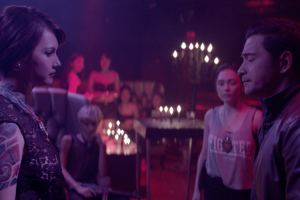
“With Maria she just wanted Adobo available for her in her tent and a bottle of tequila, which was cool. “
I think while she was here she also fell in love with Manila, especially with the weather and the nightlife, as since then she’s now opened a bar in the Remington Hotel close to Resorts World. It’s a gentleman’s bar, and because she owns a management agency in Japan, sometimes she brings the AV (adult video) girls signed to her agency to Manila for a show, which is great. (laughter)
Nilalang ended up being perfect timing for both of us, as one time I was talking with her onset, and she said it’s really like a dream come true, because she’d been on the radio talking about how she wants to do a movie, and the next day we called and invited her to star in ours. (laughter) Her Japanese managers are very excited about her work in Manila, and have even said that if we were to shoot another movie with her in Japan, they’d be willing to help us. I think for some reason the Japanese film industry is really looking to branch out more, looking into co-productions and filming overseas. It’s funny because when I first went to L.A. and New York with Nilalang, everyone I spoke to had assumed it was a Filipino/Japanese co-production, believing that the reason why it looks so glossy must be because the post was taken care of in Japan. But dude, the post was done 100% in my post-production house. I had 18 people working on the post for a period of 6 months, so it can be done.
The thing that’s happening right now in Manila with genre films, is that we have a lot of directors who are scared of doing them, simply because no producer here in their right mind would put the amount of money required behind a local genre film. The only reason I got the money was because one of our main producers is a really big fan of action, and Wesley is both the manager of Ozawa and also a big fan of action, and when I pitched them the idea I told them it’s not supposed to be a Manila based story. That’s why many of the critics in Manila really disliked it, but many of the critics overseas were much more favourable. There’s a lot of critics here locally that love action movies, but they just didn’t like Nilalang, for example guys like Philbert Dy, who hated it. I hate him! I’m just kidding, everyone is entitled to their opinion. (laughter)
But the point is there’s a real split, it’s not a rom-com, it’s not your typical Filipino movie, and I hope for one that it’ll push Manila based filmmakers into creating movies that have more global content. Right now we’re stuck to the stories you always see in Manila, and if it continues that way they’re never going to reach another audience other than the local one here.
PB: Of course what’s interesting is that it’s now been shown at various different film festivals around the world, but here on your home ground, it was actually pulled from the Metro Manila Film Festival after one day!
PL: Yeah, we got pulled out on only the second day! We started in 50 cinemas, on the second day that number was down to just 13. Then we got pulled completely by the third day, and then they put us back on in January. So I said we were never expecting to make money from the film festival, but at the same time we weren’t expecting to get dropped from over 30 cinemas on just the second day! (laughter) But dude, if you know the ins and outs of the festival, especially the Metro Manila Film Festival, it’s really a cartel. It’s mostly for the big producers, so we were taken out because they needed to open up more screens to show Beauty and the Bestie and My Bebe Love. That’s why me and (Erik) Matti’s movie were pulled. It’s weird, because I won 5 awards, most of them for technical factors, while Matti won most of the acting awards, so we had 5 each, but both of our movies were pulled out.
After that, Nilalang got accepted to 8 different film festivals abroad, so there was the UK, Buenos Aries in Argentina, and 3 of them in the U.S. – L.A., New York, and Kentucky. The Kentucky one is one of the oldest horror film festivals, so we’re pretty excited about that one, and we’ll be showing at the Urban Action Showcase in New York. So the bureaucracy of the independent film community here is difficult, and we were basically shunned as an independent company. The Film Development Council recently introduced a new policy, were they said if your film makes it to a festival outside of the Philippines, they’ll pay the cost of the airfare. The guidance was if you’re screening they’ll pay for one airfare, and if you’re actually competing they’ll pay for one plus one. We ended up having to pay for our own tickets, simply because they said the festivals we’re going to be competing in aren’t on their list of festivals that were eligible for the airfare. So I asked them to give me the list of their festivals, and there were no genre film festivals listed on it, only the really big ones like Busan Film Festival, so we had to fight with them constantly, and in the end we just said forget it, we’ll pay for ourselves.
There’s just no support at all for genre filmmaking. It’s funny because if you look at the type of films that they do support, and I don’t have anything against any of the filmmakers who have made them, but they’re all movies that revolve around poverty, drugs, and the downtrodden lives in Manila. But there’s a thriving genre community here in Manila that can’t get any funding or support, despite many directors having an interest in branching out into different genres. But without support they can’t get anywhere, the good thing with us is that we own our own post-production house, so we can do everything ourselves, but other directors don’t have that access. So for a start, my group is funding a few short films that are in development next year which are all genre driven – slasher, action etc., as a way of helping out the community. Because there’s a lot of market outside the Philippines, and I’d rather encourage this type of filmmaking than resort to having to make ‘poverty porn’. (laughter)
PB: Well your next movie definitely isn’t going to fall under that label, with the Mark Dacascos starring Breach. Is the plan for this one to put Philippines action cinema back on the map?
PL: Yes, very much so, we’re all looking forward to this one. Actually we pitched the concept to Tiger Beer, and I’ll also be pitching it to their regional offices when I get back to the Manila after the AFM (American Film Market) and Urban Action Showcase, so hopefully we can get them on-board. But the thing is, they’ve already told me they want Ozawa back, so I said that’s no problem at all, if you’re paying for it of course we can bring her back. So we might end up changing, or adding more, to the story that we have now.
We already have Yoshi Sudarso confirmed, he’s excited and I think is currently wrapping up with the Power Rangers. This will be his first time in the Philippines, and he’s actually working out really hard for the role, if you see his Instagram posts, he’s looking pretty buff. We’re also writing a character for Dan Southworth, who’ll be the nemesis for Dacascos, so it’s an exciting prospect.
For Dacascos as well, I’m hoping to meet with him while I’m in the U.S. over the next few weeks. We also met up last August, and he’s really excited as it’s been a while for him to have a lead role in a pure action movie. He’s had a few villain roles lately on TV, and also tried his hand at directing, so he’s looking forward to being back front and centre. Actually in Breach you could say his character is an anti-hero, as his brother gets killed by PDEA (Philippine Drug Enforcement Agency), and he has to go home to take care of the family business and bury his brother. So the PDEA are actually going to be the villains of the piece, which is fitting considering the current climate in the Philippines.
PB: How did Dacascos get involved?
PL: I was looking for an American actor that could do action, but also someone who will appeal in Asia, and Dacascos has that Asian look. The reason I say that is I’d originally wanted a Hong Kong actor for the lead role, but Sonny and me were talking and agreed that it’ll be easier to sell if it’s an American actor. Talking to a lot of my contacts in the U.S., they all agreed that Mark would be the best choice, as he’s really big in Russia and Europe, so there should be no issues getting distribution deals there. Of course on top of those business aspects we have to think about, I’m personally a big fan of Mark as well, and believe Brotherhood of the Wolf is one of his best performances. That’s how we decided to cast Mark, and my approach is to bring in some Hong Kong guys that can star alongside him.
I even told Sonny, because he’s come on board as a co-producer, that we should bring in his boys from L.A. for the stunts, who are currently working on Marvel’s Iron Fist series. So they did most of the stunts on that series, and Sonny is going to try and get them over for Breach, which we’re both really excited for. We really want to make Breach a Manila set action movie that will stand out, not just here in Manila, but on a global scale, so I want to make it look as real as possible, especially the fights. It’s not going to be kung fu in the traditional sense of the word, but it’s definitely not going to be just your average fighting, I’d say there’ll be some of The Raid influence in there, but more Hong Kong style.
When I saw how they did the fights in The Bourne Supremacy, particularly the one that takes place in the really confined room, I want that kind of action for Breach, because it was filmed in a way that made you feel you were right there in the thick of it. For a Hollywood film, the action in that movie was really good, especially with there being so much hand-to-hand. So that’s one of the fight styles that I want to bring to Breach, but I also wanted to add in some Filipino Martial Arts, and Sonny is especially pushing for this. So we’ll have the Filipino stick fighting, and also the blades. It’s been a long time since we’ve had a Filipino martial arts movie, there’s been nothing, so now is the time.
If I remember correctly, the last Filipino martial arts movie that I really enjoyed was from the 80’s, the name was Sticks of Death, all of the fighting in that one was based on the Filipino martial arts Arnis, I think it was with Roland Dantes. That one was a really good one. So I’m very thankful to Nilalang, because it’s opened a lot of doors not only for me, but also for my production house, and allows us now to have the opportunity to make these kinds of movies again now. After production wrapped, we’ve been able to set up offices in Vietnam, and also in Hong Kong. We’re also in talks to open up an office in L.A. It’s funny, but for some reason, there are so many rich people in Vietnam! They really want to produce films, and seem to like the idea of having Vietnamese names attached as executive producers, which I don’t mind, so now we’re thinking of working with two people in Vietnam.
For Breach we’re trying to raise between 5 and 6 million dollars, and I’ve already raised about 1.5 of that locally in Escrow, and we’re meeting with producers in L.A. that will help to finance the film through our Hong Kong office, which will be cool. In that way Nilalang was kind of like a trial, or an experiment, but it was one that really paid off. What we did there cinematography wise, production design wise, action wise, now if we double our budget, we can really make a film which looks like a Hollywood movie. Of course the thing I’m most excited about it what we’ll be able to do with the action scenes with a much higher budget.
PB: It’s interesting that Vietnam want to get involved with the Filipino action movie industry, how did that come about?
PL: Well there are currently a lot of Vietnamese working in Vietnam who didn’t grow up there, so they were raised places like the States and Australia, and now they’re in Vietnam looking for ways to invest the money that they made overseas. So there’s a lot of interest in these action movies that could appeal to overseas markets, and what’s most interesting, is that once the industry people there realised I was the director of Nilalang, all they could talk about was if I could bring Maria Ozawa to Vietnam. (laughter) It’s a communist country, but actually Vietnam is the number one Asian country for Google searching her name, which is so interesting. She has a huge following there, despite the internet being regulated. So while she’s not that well known in the U.S., she’s certainly very big in Asia.
So at some point I’d like to do a film in Vietnam, there’s a lot of talented fight guys based there, and I’ve always thought it would be an awesome place to do a car chase scene, with all of those scooters that they have all over the roads there. So hopefully after Breach, we can continue making regional films, ones which have both American, local, and casts from other countries involved so that Filipino cinema can get back on the map again. After Nilalang and Breach, I’ll be signed with Viva, so I can do the films with them, and our production company Black Ops can also co-produce.
PB: Great, and I heard before Breach starts filming, you have one more movie you plan to film?
PL: Yes! It’s a very local micro-budget found footage horror film, in the style of a slasher which I love, and we’re going to film it almost completely with smart phones, so we’ll be starting to film that from next month.
PB: Well, good luck for the movie, and even more so for your time at the AMF next week and the Urban Action Showcase!
PL: Thanks Paul, let’s catch up when I’m back!
• Nilalang will be screening as part of the Urban Action Showcase in New York on the 12th November, under its English title of The Entity.



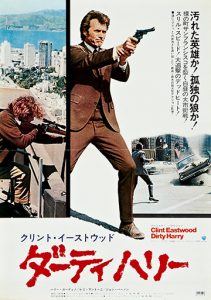















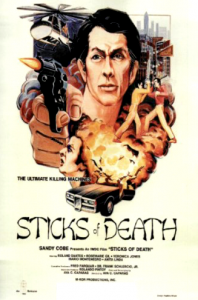



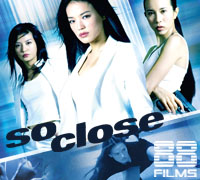
Great interview, Paul! Here in the States, I’m excited about the prospect of seeing this movie. If it’s screening soon in New York City, do you know if there are any rumblings of a Blu-ray, DVD, and/or On Demand release for “Nilalang”? Or has the film not yet acquired a distributor in North America? I’d love Well Go USA or Anchor Bay or Funimation to pick it up…
Hey HKFantatic, I heard some good news has come out of the time the crew spent at the American Film Market last week, so as soon as I hear something I’ll let you know, but I don’t think U.S. distribution should be too far away!
Great to see Filipino cinema getting maximum exposure these days. From what I’ve seen (On the Job, Metro Manila), there’s some great stuff coming out of the Philippines. Very much looking forward to Breach. Awesome interview.